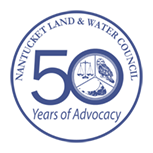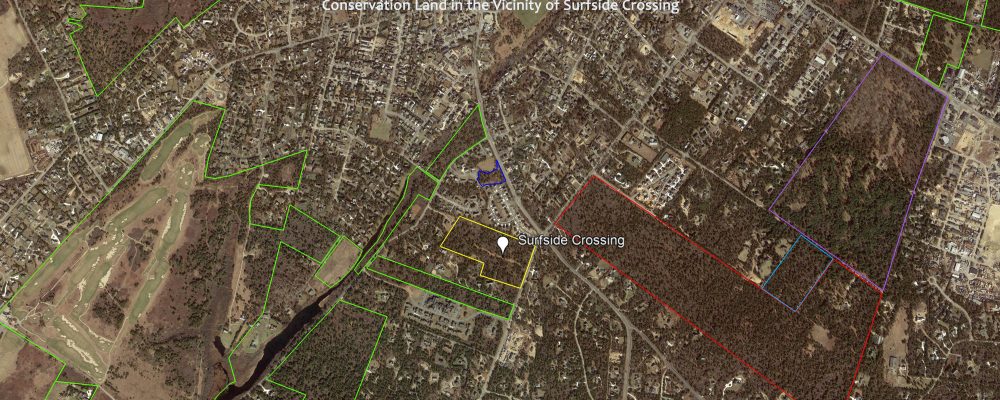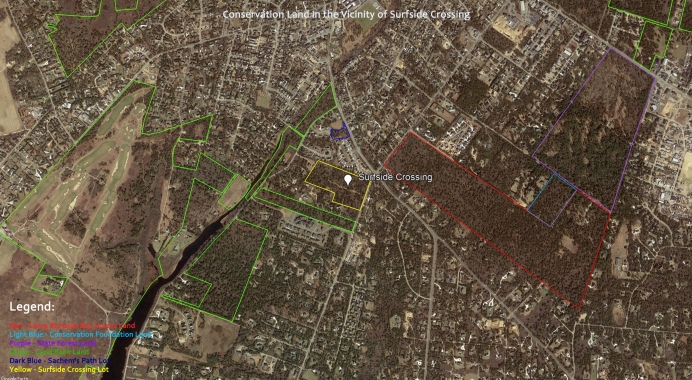The Nantucket Land & Water Council contacted the Massachusetts Department of Fisheries and Wildlife, Natural Heritage & Endangered Species Program in regards to the State protected Lepidoptera species found on the proposed site for the Surfside Crossing 40b. Read below for the Nantucket Land & Water Council’s latest communication with the State to enforce the Endangered Species Act on land proposed for the Surfside Crossing 40b.
August 9, 2018
Jesse Leddick
Chief of Regulatory Review
Natural Heritage & Endangered Species Program
MA Division of Fisheries and Wildlife
1 Rabbit Hill Road, Westborough, MA 01581
Re: Surfside Crossing Conservation and Management Permit
Dear Jesse,
I am writing in regards to Mass Heritage’s review of the proposed Surfside Crossing’s residential development. The Nantucket Land & Water Council is a non profit environmental group with a mission to protect the land and water resources of the island. Based upon previous phone conversations I have had with you along with email correspondence from you to the developer that was shared at the last Nantucket Zoning Board of Appeals hearing, it appears that Mass Heritage will potentially allow offsite mitigation to compensate for onsite impacts to State protected Lepidoptera species. You have indicated that the mitigation may come in the form of offsite habitat protection or even a monetary contribution to a management project that is deemed suitable by the State.
The Land Council has had significant involvement with Lepidoptera research on the island. Between 2000 and 2005 the Nantucket Land & Water Council funded a study to survey the entire island, employing noted lepidopterist Mark Mello from the Lloyd Center for the Environment. The purpose was two fold; first to provide a comparison to the Kimball and Jones efforts from the 1940’s and second to provide Mass Heritage with information that would allow them to better protect state listed species.
Legend:
Red – Camp Richards Boy Scouts Land
Light Blue – Conservation Foundation Land
Purple – State Forest Land
Green – Land Bank Land
Dark Blue – Sachem’s Path Lot
Yellow – Surfside Crossing proposed lot
We understand that Lepidoptera studies for this site in particular are ongoing but are expected to be complete in the coming month. At that point a formal application will be made to Mass Heritage that details the results of the surveys and how the Conservation and Management permit will be crafted.
In advance of your formal application and review process, the Nantucket Land & Water Council urges Mass Heritage to follow its own clear and concise policy steps to “Avoid, Minimize, and Mitigate”. First, the state should require the developer to “Avoid” direct impacts to host plant species then secondly, “Minimize” the impacts by requiring a smaller development footprint. This can easily be achieved by requiring a conservation restriction which we have worked with Mass Heritage and land owners to accomplish in the past. As you know the proposal is to completely clear cut the entire thirteen acre property. The Land Council finds it very concerning that the State Agency we depend on to protect our endangered species would not first mandate reasonable on site alternatives that would protect significant and sensitive habitat before determining that offsite mitigation is acceptable. We are extremely familiar with Mass Heritage’s work on the island. On site mitigation has been required for many projects in the past and should be required here.
With over 44 years of environmental protection, the Land Council is well versed in the variety of habitat throughout the island and we trust you will respect our opinions on how important this particular habitat is. It is my understanding that staff from Mass Heritage has not visited the site. However, over the phone you indicated that Mass Heritage staff did not see the ecological importance of this site as it relates to other protected areas with similar ecological habitat. I could not disagree more. I have provided an aerial view of the property that includes protected property (or soon to be) in the local vicinity. As you can see there is a large amount of Nantucket Land Bank, Nantucket Conservation Foundation and Mass State Forest property in the area. The Sachems Path conservation restriction to the north which the Land Council holds and enforces was specifically required by Mass Heritage as part of the abutting development. The conservation restriction states Conservation of the Premises will protect habitat used by a variety of state-listed rare wildlife species including, but not limited to, two state-listed plant species: New England Blazing Star (Liatris borealis), a “Species of Special Concern,” and Eastern Silvery Aster (Symphyotrichum concolor), state-listed as “Endangered”; as well as four state-listed moth species: Chain Dot Geometer (Cingilia catenaria), Pink Sallow (Psectraglaea carnosa), Coastal Swamp Metarranthis Moth (Metarranthis pilosaria), each a “Species of Special Concern,” and Melsheimer’s Sack Bearer (Cicinnus melsheimeri), state-listed as “Threatened” pursuant to the Massachusetts Endangered Species Act (MESA) (G.L. c. 131A:3 and 321 CMR 10.23). The Camp Richards Boy Scout property outlined in red, I am happy to say, was recently determined through the courts to be in local ownership and protected with a reverter clause requiring only Boy Scout use. We are currently working on a conservation restriction for the entire property. The aerial photo clearly shows how important the Surfside Crossing parcel is in connecting significant Lepidoptera habitat to the east and west. To the east the Boy Scout property continues into State Forest and then into more Land Bank and Conservation Foundation (not pictured here) all the way into thousands of acres of the Middle Moors. To the West, Land Bank land continues into Smooth Hummocks for miles. As you well know, this connectivity is vital for providing ecological corridors, enhancing species resilience to development, and promoting the movement of species throughout an ecological landscape. It is critical that on site protection is required.
Further, as I have stated to you in the past, off site management permits have not been as effective at protecting State Listed habitat as previously hoped. There are numerous on island management cases where Mass Heritage simply did not have the personnel nor the resources to ensure that not only was the permit being adhered to, but that the affected state listed species was being benefited. I sympathize with the lack of financial and personnel resources that Mass Wildlife has to endure. It is doubly difficult for the State to oversee permits on an island 40 miles out to sea. Allowing off site “management” in order to mitigate on site impacts is a flawed approach for protecting state listed species on the island and we respectfully request you do not consider it in your review of the Surfside Crossing development.
Thank you for the opportunity to express our concerns. We hope that you take these under consideration and protect significant portions of the property on site.
Sincerely,
Cormac Collier
Executive Director


